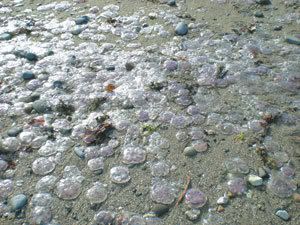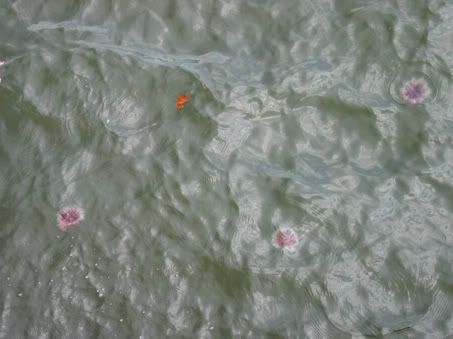Jellyfish outbreaks a sign of nature out of sync
3 days ago
PARIS (AFP) — The dramatic proliferation of jellyfish in oceans around the world, driven by overfishing and climate change, is a sure sign of ecosystems out of kilter, warn experts.
"Jellyfish are an excellent bellwether for the environment," explains Jacqueline Goy, of the Oceanographic Institute of Paris. "The more jellyfish, the stronger the signal that something has changed."
...
Two centuries worth of data shows that jellyfish populations naturally swell every 12 years, remain stable four or six years, and then subside.
2008, however, will be the eighth consecutive year that medusae, as they are also known, will be present in massive numbers.
...
Climate change has also been a boon to these domed gelatinous creatures in so far as warmer waters prolong their reproductive cycles.
But just how many millions, or billions, of jellyfish roam the seas is nearly impossible to know, said scientists.
For one things, the boneless, translucent animals -- even big ones grouped in large swarms -- are hard to spot in satellite images or sonar soundings, unlike schools of fish.
They are also resist study in captivity, which means a relative paucity of academic studies.
"There are only 20 percent of species of jellyfish for which we know the life cycle," said Goy.
And the fact that jellyfish are not commercially exploited, with the exception of a few species eaten by gastronomes in East Asia, has also added to this benign neglect.
But the measurable impact of these stinging beasts on beach-based tourism along the Mediterranean has begun to spur greater interest in these peculiar creatures whose growing presence points to dangerous changes not just in the world's oceans, but on the ground and in the air as well.
link
More and bigger jellyfish could be spotted at beaches
By Scott LaFee
UNION-TRIBUNE STAFF WRITER
June 21, 2008
They're lurking out there, beyond the Point Loma kelp beds, waiting.
Well, maybe just floating.
Purple-striped jellyfish are a sign of summer, as regular a visitor to San Diego as tourists from Iowa. In recent years, though, local sightings have risen dramatically, and exotic jellyfish species such as the black sea nettle have appeared in greater numbers.
The inevitable result: Beach-goers stung by the hundreds, in the water and on the sand, San Diegan and Iowan alike – more than 200 per day for a while last year.
Whether something similar happens again this summer remains to be seen. Those purple-striped jellies off Point Loma may not blow in toward land; the nettles might not show up.
But concerns still drift offshore. Jellyfish “blooms” seem to have increased in recent years, both in frequency and size, around the world. Some experts speculate that these blooms are a sign of sick seas, the combined consequence of environmental factors such as global warming, pollution, overfishing and habitat change.
“It's hard to know for sure,” said Richard Brodeur, a National Oceanic and Atmospheric Administration biologist based at Oregon State University who studies jellies. “We don't know much about jellyfish in general. We don't have long enough time-series studies to understand their bloom-and-bust population cycles. But it sure looks like something's happening out there.”
For creatures without bones, brains or easily recognizable internal organs, jellyfish are remarkably mysterious creatures.
Most species spend their early lives as tiny polyps anchored to underwater surfaces. At some point, miniature jellies called medusae bud from the polyp, drift off and grow up.
“They're an intractable species to study because, for the most part, we don't even know where they breed or develop,” said Claudia Mills, a jellyfish researcher affiliated with the University of Washington in Seattle. “When they are larvae or polyps, they are incredibly hard to find.”
...
link
Jellyfish invasion at Pensacola Beach
20 Jun 2008
Report by Denise Hrdlica, WALA
Photojournalist, Marcus Powe
PENSACOLA BEACH, Fla. -- It's hard to resist the crystal blue water off Pensacola Beach. But if you plan on taking a dip, be on the lookout for tentacles. I'm talking about jellyfish. There are dozens of them near the shore. Sarah Lanning had a hard time dodging them.
"There's a bunch of just little ones. They're everywhere. It's hard to maneuver around them," said Sarah Lanning.
Safety director Bob West says the jellyfish have been here for awhile.
"Unfortunately, we're in the longest stretch of jellyfish I can recall since I've been here. In fact, probably the longest time period. We've had them all the way back since before Memorial Day," said West.
...
link
The Big Sting: Tales from the Jellyfish Front in the Mediterranean
Dana Kennedy
June 18, 2008
"We've got a window of three weeks," he said. "Then - watch out. They'll be here."
"They" are the mauve stingers, the hateful jellyfish that used to be a fairly rare and occasionally cyclical occurrence in the waters off the French Riviera. But now the jellyfish invasion is a way of life not just along the Cote d'Azur but all over Europe and the planet, from the chilly Irish Sea to Australia.
The new "Jaws" has tentacles, not a dorsal fin. Think the weak dollar is your biggest problem when contemplating your European vacation this year? Think again.
Sixty million jellyfish reportedly swept the seas off Spanish beaches two years ago, stinging 70,000 people, according to this frightening Science Illustrated article.
Jellyfish are beautiful creatures but destructive - termites of the not-so-deep. And they've been around for 500 million years. Fun fact: their mouths doubles as their anuses.
They let their presence be known to me about two minutes after I dove into the pristine-looking, aquamarine waters of the Baie des Anges. Bay of Angels? There were nothing but devils in the sea today. I felt the familiar, scary electric shock on my left arm and a frisson of pain shooting from the shoulder to my wrist.
I tried to continue swimming to the far buoy 350 meters out but once you're stung, the sea no longer feels like your friend. Every tiny piece of algae or plastic bag looks like a potential source of new pain.
I think of my friend Frederic who swims way out, like me, and got stung so badly in the chest a few summers ago he thought he was having a heart attack. He wasn't, but who wants to be out in the water alone and have that happen.
I got out of the water and sat miserably on the towel. I know the drill by now. Look for a rough rock and rub your wounds as if you're grating some cheese.
For more than ten years, and especially since the summer of 2006, the jellyfish "bloom" has been increasing in alarming numbers. Articles about them abound, but nothing gets done. In nearby Cannes, city officials have been testing a giant net to filter out the "meduses" as they are called in French, to no real avail.
Our local newspaper, the Nice-Matin, ran an article last week about a swarm of baby jellyfish that looked like a big dark mass in the town of Villefranche-sur-Mer, the little town just east of Nice.
...
link






